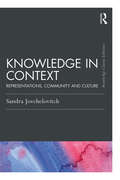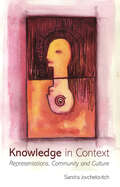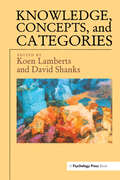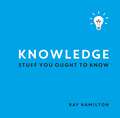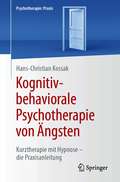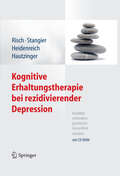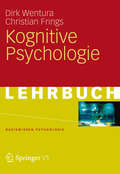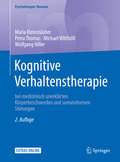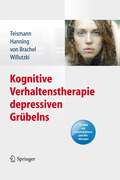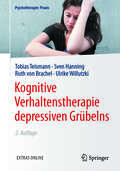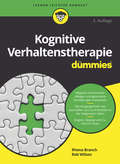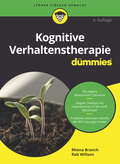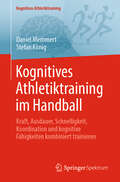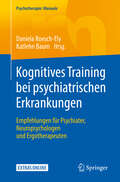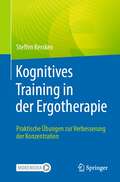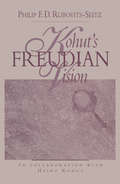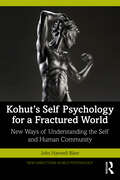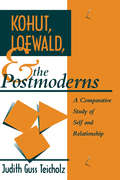- Table View
- List View
Knowledge in Context: Representations, Community and Culture (Psychology Press & Routledge Classic Editions)
by Sandra JovchelovitchIn this classic edition of her groundbreaking text Knowledge in Context, Sandra Jovchelovitch revisits her influential work on the societal and cultural processes that shape the development of representational processes in humans. Through a novel analysis of processes of representation, and drawing on dialogues between psychology, sociology and anthropology, Jovchelovitch argues that representation, a social psychological construct relating Self, Other and Object-world, is at the basis of all knowledge. Exploring the dominant assumptions of western conceptions of knowledge and the quest for a unitary reason free from the ‘impurities’ of person, community and culture, Jovchelovitch recasts questions related to historical comparisons between the knowledge of adults and children, ‘civilised’ and ‘primitive’ peoples, scientists and lay communities and examines the ambivalence of classical theorists such as Piaget, Vygotsky, Freud, Durkheim and Lévy-Bruhl in addressing these issues. Featuring a new introductory chapter, the author evaluates the last decade of research since Knowledge in Context first appeared and reassesses the social psychology of the contemporary public sphere, exploring how challenges to the dialogicality of representations reconfigure both community and selfhood in this early 21st century. This book will make essential reading for all those wanting to follow debates on knowledge and representation at the cutting edge of social, cultural and developmental psychology, sociology, anthropology, development and cultural studies.
Knowledge in Context: Representations, Community and Culture (Psychology Press And Routledge Classic Editions Ser.)
by Sandra JovchelovitchThis book explores the relationship between knowledge and context through a novel analysis of processes of representation. Sandra Jovchelovitch argues that representation, a social psychological construct relating self, other and object-world, is at the basis of all knowledge. Understanding its genesis and actualisation in individual and social life explains what ties knowledge to persons, communities and cultures. It is through representation that we can appreciate the diversity of knowledge, and it is representation that opens the epistemic function of knowing to emotional and social rationalities. Drawing on dialogues between psychology, sociology and anthropology, Jovchelovitch explores the dominant assumptions of western conceptions of knowledge and the quest for a unitary reason free from the ‘impurities’ of person, community and culture. She recasts questions related to historical comparisons between the knowledge of adults and children, ‘civilised’ and ‘primitive’ peoples, scientists and lay communities and examines the ambivalence of classical theorists such as Piaget, Vygotsky, Freud, Durkheim and Lévy-Bruhl in addressing these issues. Against this background, Jovchelovitch situates and expands Moscovici’s theory of social representations, developing a framework to diagnose and understand knowledge systems, how they relate to different communities and what defines dialogical and non-dialogical encounters between knowledges in contemporary public spheres. Diversity in knowledge, she shows, is an asset of all human communities and dialogue between different forms of knowing constitutes the difficult but necessary task that can enlarge the frontiers of all knowledges. Knowledge in context will make essential reading for all those wanting to follow debates on knowledge and representation at the cutting edge of social, cultural and developmental psychology, sociology, anthropology, development and cultural studies.
Knowledge, Concepts And Categories (Studies in Cognition)
by Koen Lamberts David ShanksThis text brings together an overview of recent research on concepts and knowledge that abstracts across a variety of specific fields of cognitive psychology. Readers will find data from many different areas, including developmental psychology, formal modelling, neuropsychology and connectionism.
Knowledge, Information and Creativity Support Systems
by George Angelos Papadopoulos Janusz Kacprzyk Susumu Kunifuji Andrzej M. J. SkulimowskiThisvolume consists of a number of selected papers thatwere presented at the 9th International Conference on Knowledge, Informationand Creativity Support Systems (KICSS 2014) in Limassol, Cyprus, after theywere substantially revised and extended. The 26 regularpapers and 19 short papers included in this proceedings cover all aspects ofknowledge management, knowledge engineering, intelligent information systems,and creativity in an information technology context, including computationalcreativity and its cognitive and collaborative aspects.
Knowledge: Stuff You Ought to Know
by Ray HamiltonThis outrageously informative book is packed full of fascinating nuggets of history, science, literature, technology, sports, geography, culture and miscellanea from every corner of the world – enough mind-blowing trivia to ensure you’re never short of a jaw-dropping conversation starter (or stopper) again.
Knowledge: Stuff You Ought to Know
by Ray HamiltonThis outrageously informative book is packed full of fascinating nuggets of history, science, literature, technology, sports, geography, culture and miscellanea from every corner of the world – enough mind-blowing trivia to ensure you’re never short of a jaw-dropping conversation starter (or stopper) again.
Kognitiv-behaviorale Psychotherapie von Ängsten: Kurztherapie mit Hypnose - die Praxisanleitung (Psychotherapie: Praxis)
by Hans-Christian KossakIn diesem Praxismanual erfahren Psychotherapeuten, wie sie mit Kurztherapie bei vielen Patienten mit Ängsten schnell und dauerhaft wirksam werden können. Dr. Kossak kombiniert die beiden effektiven Methoden Hypnose und kognitive Verhaltenstherapie: Sie wirkt meist bereits unmittelbar nach nur einer Sitzung. Klar gegliedert führt der Autor in die zugrundeliegenden Theorien der Methode ein, die dann im umfangreichen Praxisteil direkt nutzbar werden. Die Falldarstellungen mit Studienfragen machen diese Behandlung konkret nachvollziehbar. Die Effektivität ist durch große, anhaltende Katamnesezeiträume belegt. Geschrieben für ... Psychotherapeuten, Ärzte, Psychiater, Psychologen, Zahnärzte, Coaches und Studierende in diesen Fächern. Über den Autor: Dr. Hans-Christian Kossak, Dipl.-Psych., Psychologischer Psychotherapeut und Kinder- und Jugendlichenpsychotherapeut mit Ausbildungszertifikaten in Verhaltenstherapie, Gesprächspsychotherapie, Hypnosetherapie. Gründer der Psychotherapie in der Kombination von kognitiver Verhaltenstherapie und Hypnose. Schwerpunkt: Ängste, Psychosomatik, Lern- und Leistungsstörungen. Er war Leiter der Katholischen Beratungsstelle für Erziehungs- und Familienfragen, Bochum; Dozent und Ausbilder von Psychotherapeuten in Hypnose und Verhaltenstherapie; Referent auf Fachkongressen. Autor zahlreicher wissenschaftlicher Fachartikel und Fachbücher.
Kognitive Erhaltungstherapie bei rezidivierender Depression
by Ulrich Stangier Thomas Heidenreich Martin Hautzinger Anne Kathrin RischRezidivierende Depression: Rückfälle verhindern, psychische Gesundheit erhalten Depressionen gehören zu den häufigsten psychischen Störungen. Von dem Anteil der Betroffenen, die Therapie erhalten, erlebt eine hohe Anzahl Rückfälle - das ist anstrengend für Betroffene und Therapeuten. Und das ist teuer für Krankenkassen und Arbeitgeber. Problem: Die "Rückfälligen" werden bisher jeweils wie akut Erkrankte behandelt, ohne dass die Vorgeschichte berücksichtigt wird. Neue Forschungen zeigen: Erst die Mischung von klassisch verhaltenstherapeutischen Interventionen mit Maßnahmen aus dem nichtklinischen Bereich (z.B. Achtsamkeit, Akzeptanz, psychologisches Wohlbefinden, Werteorientierung) bringt den vollen Erfolg. Praxisorientiert: Aufbau am Bedarf der Praktiker orientiert Dieses Buch ist geschrieben für Verhaltenstherapeuten in Ausbildung und Praxis, klinische Psychologen, Psychiater, psychologische und ärztliche Psychotherapeuten - und gliedert sich in 3 Teile: Symptomatik, Klassifikation, Epidemiologie, Diagnostik der rezidivierenden Depression.Therapieprogramm in 6 Modulen (für die Arbeit im Einzelsetting).Alle nötigen Arbeitsmaterialien (und zwei Hörbeispiele für angeleitete Übungen), die der Therapeut bei seiner Arbeit braucht (auf CD-ROM).Mit CD-ROM: Alle Arbeitsblätter zum Ausdrucken plus 2 Podcasts mit Übungen
Kognitive Psychologie
by Dirk Wentura Christian FringsWas ist Kognitive Psychologie? Welche Themen, Debatten und Forschungsergebnisse bewegen das Fach? Das Buch liefert Antworten und verschafft einen fundierten Überblick. Kritisch und nachdenklich werden z.B. die Stellung der Kognitiven Psychologie innerhalb der Psychologie, ihre Entwicklung zu einer modernen Wissenschaft, methodische Bezüge und ihre klassischen Gebiete erläutert und reflektiert. Historische Exkurse, Schilderungen von berühmten Experimenten und zahlreiche Beispiele tragen zum lebendigen und verständlichen Stil dieser Einführung bei.
Kognitive Verhaltenstherapie bei Hypochondrie und Krankheitsangst: Mit 18 Abbildungen, 23 Tabellen Und 26 Arbeitsbla¨ttern (Psychotherapie: Praxis)
by Florian Weck Gaby BleichhardtDas Behandlungsmanual gibt Psychotherapeuten eine umfassende Anleitung zum Umgang mit krankheitsängstlichen Patienten. Von Ärzten und Psychotherapeuten wird diese Klientel zum Teil als schwierig empfunden – umso wichtiger ist die fachkundige, auf die Patientengruppe abgestimmte psychotherapeutische Behandlung. Die Angst vor Krankheit und Tod kennt jeder, es sind Urängste des Menschen. Massive und andauernde Krankheitsangst ist eine ernstzunehmende psychische Störung, die mit persönlichem Leid und psychosozialen Beeinträchtigungen einhergehen kann.Aus dem Inhalt: I Grundlagen: (1) Symptome des Störungsbildes – (2) Diagnostik, Epidemiologie, kognitiv-behaviorales Gesamtmodell – (3) Aktueller wissenschaftlicher Stand zu Hypochondrie und Krankheitsangst. – II Praxis: (1) Manualisiertes, kognitiv-behaviorales Programm für die Einzeltherapie, plus Übungen und Module für Therapiegruppen – (2) Hilfestellung für mögliche Komplikationen und Spezialfälle (z. B. Krankheitsangst bei vorhandenen Krankheiten) – (3) Verhaltensübungen, Formulierungsvorschläge und Dialogbeispiele, Arbeits- und Informationsblätter (zum Download und Ausdrucken im Internet).Über die Autoren: Dr. Gaby Bleichhardt arbeitet in der Leitung der Psychotherapie-Ambulanz Marburg an der Philipps-Universität Marburg. Prof. Dr. Florian Weck leitet die Abteilung für Klinische Psychologie und Psychotherapie an der Universität Potsdam.
Kognitive Verhaltenstherapie bei medizinisch unerklärten Körperbeschwerden und somatoformen Störungen
by Wolfgang Hiller Maria Kleinstäuber Petra Thomas Michael WitthöftJeder fünfte Patient in Deutschland leidet an organischen Beschwerden, ohne dass jemals eine Ursache gefunden wird. Um unnötige diagnostische Verfahren und falsche Behandlungen zu vermeiden, bieten sich vor allem die kognitiven Therapien an. Dieses erste Manual seiner Art liefert einen Leitfaden zur kognitiven Verhaltenstherapie in sieben strukturierten Einzelmodulen und gibt Therapeuten klare Anweisungen. Der Band enthält Arbeitsblätter und weitere Materialien zur unmittelbaren Nutzung.
Kognitive Verhaltenstherapie depressiven Grübelns
by Ruth Von Brachel Tobias Teismann Ulrike Willutzki Sven HanningGrübeln gilt als ein zentraler Faktor sowohl für die Entstehung und Fortdauer depressiver Störungen wie auch für Rückfälle. Das Manual bietet die erste deutschsprachige Anleitung zur Therapie depressiven Grübelns. Basierend auf aktuellen Befunden der Grundlagenforschung wird die Gestaltung einer gruppentherapeutischen Behandlung detailliert beschrieben und theoretisch fundiert erläutert. Die vorgeschlagenen therapeutischen Strategien lassen sich auch bei Einzeltherapien einsetzen. Mit Arbeitsmaterial und Hörübungen auf beiliegender CD-ROM.
Kognitive Verhaltenstherapie depressiven Grübelns
by Ruth Von Brachel Tobias Teismann Ulrike Willutzki Sven HanningDieses Buch zeigt Psychotherapeuten, Psychiatern und Beratern detailliert die Gestaltung einer gruppentherapeutischen Behandlung und ist angepasst an die Behandlung von Patienten, die an leichteren Formen unipolarer Depressionen leiden. Sämtliche der beschriebenen therapeutischen Strategien lassen sich zudem im einzeltherapeutischen Kontext nutzen. Die Arbeitsblätter im Buch stehen im Internet zum Download zur Verfügung. Dort finden sich auch vier Hörübungen für Patienten.Aus dem InhaltI Theorie – II Praxis und Behandlungsmanual – Teilnehmermaterialien.
Kognitive Verhaltenstherapie für Dummies (Für Dummies)
by Rob Willson Rhena BranchViele Menschen leiden unter Depressionen, Ängsten, Essstörungen, Schlafstörungen oder Abhängigkeiten. Sie suchen Hilfe, ohne gleich eine kostspielige und langwierige Therapie machen zu wollen. Die Autoren Rob Willson und Rhena Branch haben als Verhaltenstherapeuten langjährige praktische Erfahrung mit Patienten. Leicht verständlich führen sie in die Kognitive Verhaltenstherapie ein. Sie erläutern, wie Gedanken und Verhaltensmuster unser Empfinden beeinträchtigen können und zeigen ganz praktische Wege zu einer neuen Sicht der Dinge. Wer lernt, seine Denkweise zu verändern, wird sich bald besser fühlen.
Kognitive Verhaltenstherapie für Dummies (Für Dummies)
by Rob Willson Rhena BranchViele Menschen leiden unter Depressionen, Ängsten, Essstörungen, Schlafstörungen oder Abhängigkeiten. Durch die Corona-Pandemie hat ihre Zahl noch deutlich zugenommen. Die Autoren Rob Willson und Rhena Branch haben als Verhaltenstherapeuten langjährige praktische Erfahrung mit Patienten und führen leicht verständlich in die Kognitive Verhaltenstherapie ein. Sie erläutern, wie Gedanken und Verhaltensmuster unser Empfinden beeinträchtigen können, und zeigen ganz praktische Wege zu einer neuen Sicht der Dinge auf. Wer lernt, seine Denkweise zu verändern, wird sich bald besser fühlen.
Kognitive Verhaltenstherapie für Patienten mit leichter Alzheimer-Demenz und ihre Angehörigen
by Simon Forstmeier Tanja RothDieses Manual bietet erstmals ein umfassendes psychotherapeutisches Behandlungsprogramm für Personen mit einer beginnenden Alzheimer-Demenz und ihre Angehörigen auf Basis der kognitiven Verhaltenstherapie. Das Therapiekonzept beinhaltet sowohl etablierte verhaltenstherapeutische Interventionen wie Aktivitätenaufbau, aber auch alterspsychotherapeutische Elemente wie einen strukturierten Lebensrückblick sowie paartherapeutische Interventionen. Das Behandlungsprogramm wurde bereits erfolgreich wissenschaftlich evaluiert. Der Leser findet eine Anleitung für jede Sitzung und alle dazugehörigen Arbeitsmaterialien für die Patienten.Geschrieben für Psychologische und Ärztliche Psychotherapeuten, Psychiater, Hausärzte mit gerontologischem Schwerpunkt, Klinische Neuropsychologen.Aus dem InhaltI Grundlagen – II Therapie – III Materialien. Alle Materialien zum Download im Internet.
Kognitives Athletiktraining im Fußball: Kraft, Ausdauer, Schnelligkeit, Koordination und kognitive Fähigkeiten kombiniert trainieren (Kognitives Athletiktraining)
by Daniel Memmert Sebastian Schwab Claudius LudwigDie Buchreihe Kognitives Athletiktraining informiert in praxisorientierten und wissenschaftlich fundierten Einzelbänden über die Durchführung eines kognitiven Athletiktrainings in verschiedenen Sportarten. Jeder Reihentitel greift eine spezifische Sportart auf und beantwortet die übergeordnete Frage: „Mit welchen Spiel- und Übungsformen kann die Kognition parallel zu Athletik und Kondition trainiert werden?&“ Dabei stehen kognitive Fähigkeiten wie z. B. Wahrnehmung, Kreativität, Antizipation und Aufmerksamkeit sowie konditionelle Fähigkeiten wie Kraft, Ausdauer, Schnelligkeit und Koordination im Fokus. Die Bücher sind didaktisch-methodisch ausgelegt, enthalten viele Beispiele und überzeugen durch eine kompakte und übersichtliche Aufmachung im Theorieteil. Zahlreiche Fotos und Abbildungen erleichtern die Umsetzung der verschiedenen Spiel- und Übungsformen im Praxisteil, der den wesentlichen Anteil der Bücher ausmacht. Die Buchreihe richtet sich insbesondere an Trainer*innen im Leistungs- und Breitensport, an interessierte Sportler*innen sowie an Studierende der Sportwissenschaft. Die Autor*innen der Reihentitel lehren und forschen an Universitäten, sind selbst als Trainer*innen aktiv oder engagieren sich in den Dachverbänden der jeweiligen Sportarten.
Kognitives Athletiktraining im Handball: Kraft, Ausdauer, Schnelligkeit, Koordination und kognitive Fähigkeiten kombiniert trainieren (Kognitives Athletiktraining)
by Daniel Memmert Stefan KönigDie Buchreihe Kognitives Athletiktraining informiert in praxisorientierten und wissenschaftlich fundierten Einzelbänden über die Durchführung eines kognitiven Athletiktrainings in verschiedenen Sportarten. Jeder Reihentitel greift eine spezifische Sportart auf und beantwortet die übergeordnete Frage: „Mit welchen Spiel- und Übungsformen kann die Kognition parallel zu Athletik und Kondition trainiert werden?&“ Dabei stehen kognitive Fähigkeiten wie z. B. Wahrnehmung, Kreativität, Antizipation und Aufmerksamkeit sowie konditionelle Fähigkeiten wie Kraft, Ausdauer, Schnelligkeit und Koordination im Fokus. Die Bücher sind didaktisch-methodisch ausgelegt, enthalten viele Beispiele und überzeugen durch eine kompakte und übersichtliche Aufmachung im Theorieteil. Zahlreiche Fotos und Abbildungen erleichtern die Umsetzung der verschiedenen Spiel- und Übungsformen im Praxisteil, der den wesentlichen Anteil der Bücher ausmacht. Die Buchreihe richtet sich insbesondere an Trainer*innen im Leistungs- und Breitensport, an interessierte Sportler*innen sowie an Studierende der Sportwissenschaft. Die Autor*innen der Reihentitel lehren und forschen an Universitäten, sind selbst als Trainer*innen aktiv oder engagieren sich in den Dachverbänden der jeweiligen Sportarten.
Kognitives Athletiktraining im Klettern und Bouldern: Kraft, Ausdauer, Schnelligkeit, Koordination und kognitive Fähigkeiten kombiniert trainieren (Kognitives Athletiktraining)
by Daniel Memmert Jerry MedernachDie Buchreihe Kognitives Athletiktraining informiert in praxisorientierten und wissenschaftlich fundierten Einzelbänden über die Durchführung eines kognitiven Athletiktrainings in verschiedenen Sportarten. Jeder Reihentitel greift eine spezifische Sportart auf und beantwortet die übergeordnete Frage: „Mit welchen Spiel- und Übungsformen kann die Kognition parallel zu Athletik und Kondition trainiert werden?&“ Dabei stehen kognitive Fähigkeiten wie z. B. Wahrnehmung, Kreativität, Antizipation und Aufmerksamkeit sowie konditionelle Fähigkeiten wie Kraft, Ausdauer, Schnelligkeit und Koordination im Fokus. Die Bücher sind didaktisch-methodisch ausgelegt, enthalten viele Beispiele und überzeugen durch eine kompakte und übersichtliche Aufmachung im Theorieteil. Zahlreiche Fotos und Abbildungen erleichtern die Umsetzung der verschiedenen Spiel- und Übungsformen im Praxisteil, der den wesentlichen Anteil der Bücher ausmacht. Die Buchreihe richtet sich insbesondere an Trainer*innen im Leistungs- und Breitensport, an interessierte Sportler*innen sowie an Studierende der Sportwissenschaft. Die Autor*innen der Reihentitel lehren und forschen an Universitäten, sind selbst als Trainer*innen aktiv oder engagieren sich in den Dachverbänden der jeweiligen Sportarten.
Kognitives Training bei psychiatrischen Erkrankungen: Empfehlungen für Psychiater, Neuropsychologen und Ergotherapeuten (Psychotherapie: Manuale)
by Daniela Roesch-Ely Katlehn BaumZahlreiche psychiatrische Erkrankungen gehen mit kognitiven Störungen einher, die die Alltagsfunktionalität der Patienten teils erheblich einschränken. In diesem Buch geben die Herausgeberinnen einen Überblick über kognitive Störungen bei ausgewählten Erkrankungen wie Schizophrenie, affektiven Erkrankungen, adultem ADHS und Autismus-Spektrum-Störungen und präsentieren praxisnahe Empfehlungen zu Planung, Struktur und praktischer Umsetzung entsprechender kognitiver Trainingsprogramme. Abgerundet wird das Manual durch entsprechende Fallbeispiele sowie verschiedene Informations- und Arbeitsblätter, die zum Download zur Verfügung stehen.Dieses Manual entstand in der Psychiatrischen Ambulanz für Kognitives Training (PAKT) des Universitätsklinikums Heidelberg und richtet sich an Psychiater, Neuropsychologen und Ergotherapeuten, die Patienten mit psychiatrischen Erkrankungen und assoziierten kognitiven Defiziten behandeln.
Kognitives Training in der Ergotherapie: Praktische Übungen zur Verbesserung der Konzentration
by Steffen KerskenDieses Praxisbuch liefert alles Wesentliche für das kognitive Training in der Ergotherapie. Welche Assessments sind zur Erfassung der Hirnleistung sinnvoll? Eignet sich eine ergotherapeutische Übung zur Förderung von Konzentration? Wie kann ich meine Patient*innen hinsichtlich Problemlösungs- und Entscheidungsfähigkeit unterstützen? Hier finden Sie die Antworten zu allen Aspekten des Hirnleistungstrainings. Aus dem Inhalt: Kreative und handlungsorientierte Übungen auf Basis eines sechssäuligen Therapiekonzeptes, Berufsbelastungsübungen, Präsentationen und Arbeitsstrategien, Förderung von Konzentration, Belastbarkeit und Aufmerksamkeit, Pausen- und Energiemanagement, Stressbewältigung mit zusätzlichen Arbeitsblättern zum Download.Gönnen Sie sich und Ihren Patient*innen etwas Abwechslung und bereichern Sie Ihr Behandlungsrepertoire um eine Vielzahl von kreativen Übungen.
Kohut's Freudian Vision
by Philip F. Rubovits-SeitzHeinz Kohut was arguably the most influential modern day psychoanalyst. Because current interest in Kohut's work has focused so completely on self psychology, however, certain aspects of Kohut's thinking, in particular his nonreductive synthesis of Freudian theory, are in danger of being lost. Prior to his development of self psychology, Kohut was a legendary teacher of Freudian theory at the Chicago Institute for Psychoanalysis. In this volume, Philip Rubovits-Seitz presents Kohut's previously unavailable lectures from his course on psychoanalytic psychology (prepared in collaboration with Kohut himself) along with an illuminating summary statement on Freudian theory jointly written by Kohut and Rubovits-Seitz.Rubovits-Seitz continues with his own insightful analysis of Kohut's distinctive approach to Freudian theory. And he concludes by arguing persuasively why Kohut's later contributions should best be viewed as a continuation, rather than an abandonment, of this early vision. Kohut's Freudian Vision not only repairs an outstanding tear in received psychoanalytic history but also challenges self psychologists and contemporary Freudian psychoanalysts alike to renewed reflection.
Kohut's Self Psychology for a Fractured World: New Ways of Understanding the Self and Human Community (New Directions in Self Psychology)
by John Hanwell RikerDrawing from Kohut's conceptualisation of self, Riker sets out how contemporary America's formulation of persons as autonomous, self-sufficient individuals is deeply injurious to the development of a vitalizing self-structure—a condition which lies behind much of the mental illness and social malaise of today's world.By carefully attending to Kohut's texts, Riker explains the structural, functional, and dynamic dimensions of Kohut's concept of the self. He creatively extends this concept to show how the self can be conceived of as an erotic striving for connectedness, beauty, and harmony, separate from the ego. Riker uses this distinction to reveal how social practices of contemporary American society foster skills and traits to advance the aims of the ego for power and control, but tend to suppress the needs of the self to authentically express its ideals and connect with others. The book explores the impact that this view can have on clinical practice, and concludes by imaginatively constructing an ideal self-psychological society, using Plato's Republic as a touchstone.Informed by self psychology and philosophy, this book is essential reading for psychoanalysts, psychotherapists and philosophers, seeking to revisit and revise constructions of both self and humanity.
Kohut's Twinship Across Cultures: The Psychology of Being Human (Psychoanalytic Inquiry Book Series)
by Koichi Togashi Amanda KottlerKohut's Twinship Across Cultures: The Psychology of Being Human chronicles a 10-year-voyage in which the authors struggled, initially independently, to make sense of Kohut‘s intentions when he radically re-defined the twinship experience to one of "being human among other human beings". Commencing with an exploration of Kohut’s work on twinship and an illustration of the value of what he left for elaboration, Togashi and Kottler proceed to introduce a new and very different sensitivity to understanding particular psychoanalytic relational processes and ideas about human existential anguish, trauma, and the meaning of life. Together they tackle the twinship concept, which has often been misunderstood and about which little has been written. Uniquely, the book expands and elaborates upon Kohut’s final definition, "being human among other human beings." It problematizes this apparently simple concept with a wide range of clinical material, demonstrating the complexity of the statement and the intricacies involved in recognizing and working with traumatized patients who have never experienced this feeling. It asks how a sense of being human, as opposed to being described as human, can be generated and how this might help clinicians to better understand and work with trauma. Written for psychoanalysts and psychoanalytic psychotherapists interested in self-psychological, intersubjective, and relational theories, Twinship Across Cultures will also be invaluable to clinicians working in the broader areas of psychoanalysis, psychotherapy, social work, psychiatry and education. It will enrich their sensitivity and capacity to understand and treat traumatized patients and the alienation they feel among other human beings.
Kohut, Loewald and the Postmoderns: A Comparative Study of Self and Relationship (Psychoanalytic Inquiry Book Series #No. 18)
by Judith G. TeicholzIn Kohut, Loewald, and the Postmoderns, Judith Teicholz, using the contemporary critique of Kohut and Loewald as a touchstone of inquiry into the current status of psychoanalysis, focuses on a select group of postmodern theorists whose recent writings comprise a questioning subtext to Kohut's and Loewald's ideas. Acutely aware of the important differences among these theorists, Teicholz nonetheless believes that their respective contributions, which present psychoanalysis as an interactive process in which the analyst's own subjectivity plays a constitutive role in the joint construction of meanings, achieve shared significance as a postmodern critique of Kohut and Loewald. She is especially concerned with the relationship - both theoretically and technically -between Kohut's emphasis on the analyst's empathic resonance with the analysand's viewpoint and affect, and the postmodern theorists' shared insistence on the expression of the analyst's own subjectivity in the treatment situation. Her analysis incorporates fine insight into the tensions and ambiguities in Kohut and Loewald, whose work ultimately emerges as a way station between modern and postmodern viewpoints, and her appreciation of Kohut and Loewald as transitional theorists makes for an admirably even-handed exposition. She emphasizes throughout the various ways in which Kohut and Loewald gave nascent expression to postmodern attitudes, but she is no less appreciative of the originality of postmodern theorists, who address genuine lacunae in the thought and writings of these exemplars of an earlier generation. Teicholz's examination of what she terms two overlapping "partial revolutions" in psychoanalysis - that of Kohut and Loewald on one hand and of the postmoderns on the other - throws an illuminating searchlight on the path psychoanalysis has traveled over the last quarter of the 20th century.
